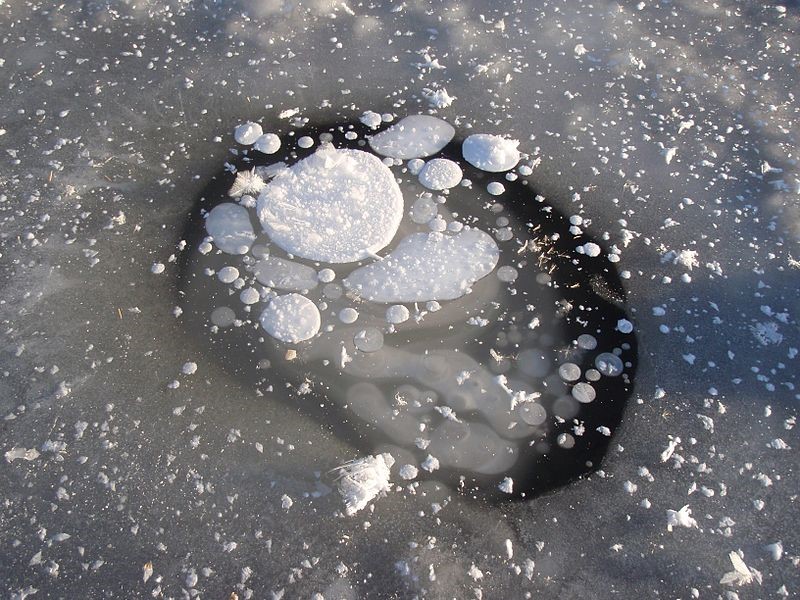 Image Courtesy of the United States Geological Survey
Image Courtesy of the United States Geological Survey
Exploding Methane Bubbles in Siberia: A Threat to Russian and EU Energy Security?
By Katherine Weingartner WiSe Fellow
Climate change impacts have the ability to magnify insecurity in perhaps unexpected ways. Explosions triggered by methane being released from thawing Siberian permafrost have the potential to damage Russian oil and natural gas pipelines. Damage to this infrastructure could not only have notable economic and energy repercussions for Russia, but could threaten European Union (EU) energy security. As climate change transforms Arctic and sub-Arctic regions, it is important to recognize how these changes can have cascading effects that create greater instability.
Russian Oil and Gas Infrastructure at Risk from Exploding Methane Bubbles
As Siberian permafrost thaws, the resulting explosions of previously trapped methane pose a threat to Russian natural gas and oil pipelines. In 2017, Russian scientists detected around 7,000 underground methane bubbles in Siberia which have the potential to explode at any moment. Several such explosions have occurred in the Yamal Peninsula region of Siberia, creating large craters, some of which have been 50 meters deep and tens of meters wide. These explosions jeopardize Russian gas pipelines as the Yamal Peninsula contains Russia’s largest and most valuable natural gas reserves. In some areas, swelling tundra is already pushing up gas pipelines. Russian oil pipelines, such as the Eastern Siberia-Pacific Ocean (ESPO) pipeline, may also be in danger from these explosions.
Implications for Russian Energy Security
Recognizing Russia’s dependence on oil and gas to provide for its domestic energy needs, pipeline damage from methane bubble explosions can cause challenges to Russian energy security. In 2016, Russia was the world’s fourth largest energy consumer, accounting for 5.1 percent of global energy consumption. In 2014, 88 percent of Russian primary energy consumption came from fossil fuels, with 54 percent and 22 percent coming from natural gas and oil, respectively. As indicated in Russia’s Energy Strategy for the Period until 2035, fossil fuels will remain responsible for almost 90 percent of the country’s domestic energy mix, though in the future, it is projected that gas will make up a larger portion of the energy mix. Both now and in the future, Russian domestic energy consumption needs may be at risk from continued permafrost thaw.
The Value of Oil and Gas for the Russian Economy
Oil and gas production play a critical role in the Russian economy and a threat to its infrastructure, particularly in Siberia, can have notable consequences. Russia ranks first in crude oil production and second in dry natural gas production in the world. In 2015, 43 percent of Russia’s federal budget revenue came from oil and gas revenues. Siberia, where pipeline infrastructure is at risk from exploding methane bubbles, is a major area of Russian production. In 2016, the Yamal-Nenets region was responsible for around 90 percent of Russian natural gas production. Similarly, the majority of Russian oil production takes place in West Siberia and the Urals-Volga regions. Whereas other Russian Arctic areas have seen significant population decline, the number of people in the Yamal-Nenets region has grown from 60,000 in 1960 to over 530,000 in 2016, fueled in large part by the economic opportunities to harvest its oil and gas.
Russia’s global export market is particularly dependent on oil and gas, which still made up 62 percent of Russian exports in 2015 despite the global collapse of oil prices. Russian oil and gas exports focus primarily on a single export market – the EU. In 2014, the EU accounted for 46 percent of total Russian exports, the majority of which came from oil and gas. This trend continued in 2015 when nearly 75 percent of Russian natural gas exports and 60 percent of Russian crude exports found their way to Europe. If Russian exports to the EU were disrupted due to climate-induced explosions of methane bubbles in pipeline areas, it could not only have major impacts on the Russian economy, but could endanger EU energy security.
European Union Energy Security Tied to Russian Supplies
Despite efforts by the European Union (EU) to reduce its dependence on Russian oil and gas, it is likely that the EU will remain reliant on Russian imports for decades to come. In 2015, the EU imported nearly 30 percent of their crude oil from Russia. According to BP, EU consumption of Russian gas will increase from over 30 percent today to 40 percent by 2035. Recognizing that Russia is a major supplier of oil and gas to the EU, supply disruptions from damaged pipeline infrastructure could have many implications for the safety and security of EU citizens and the EU economy.
Arctic and sub-Arctic climate changes can contribute to insecurity in ways which may not be immediately apparent. By recognizing how methane release from thawing permafrost has the possibility of creating economic and energy security implications for Russia and the EU, efforts can be made to mitigate these threats.
Katherine Weingartner is a WiSe Fellow and program consultant at ICF, a global consulting firm that works in environmental and security issues. Ideas expressed are the author’s and do not necessarily represent the views of ICF.






